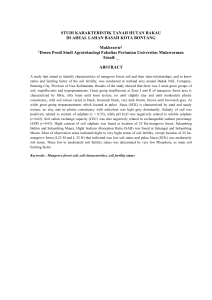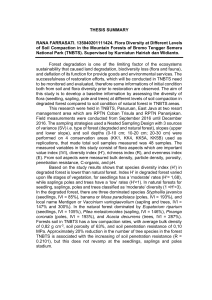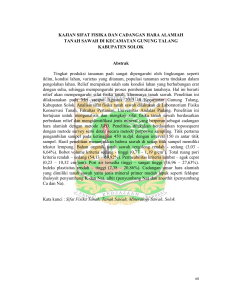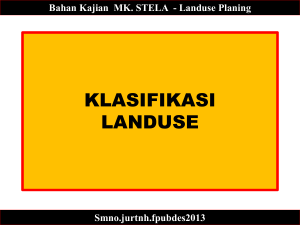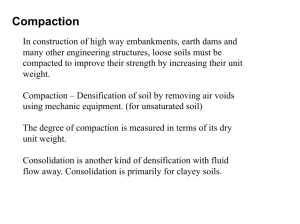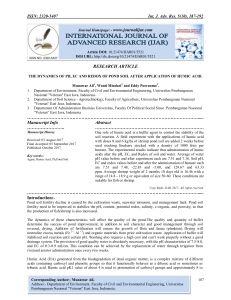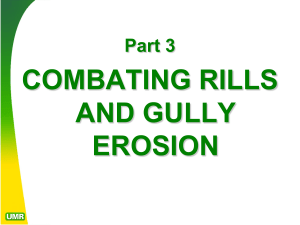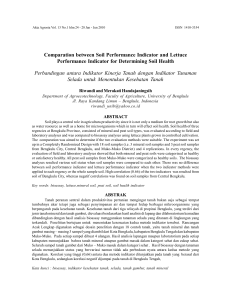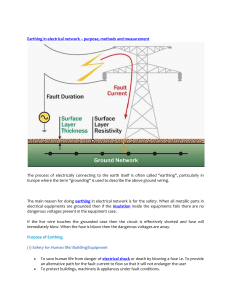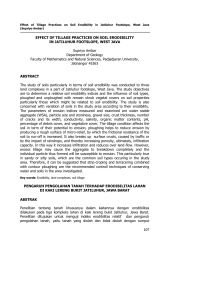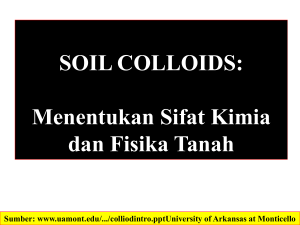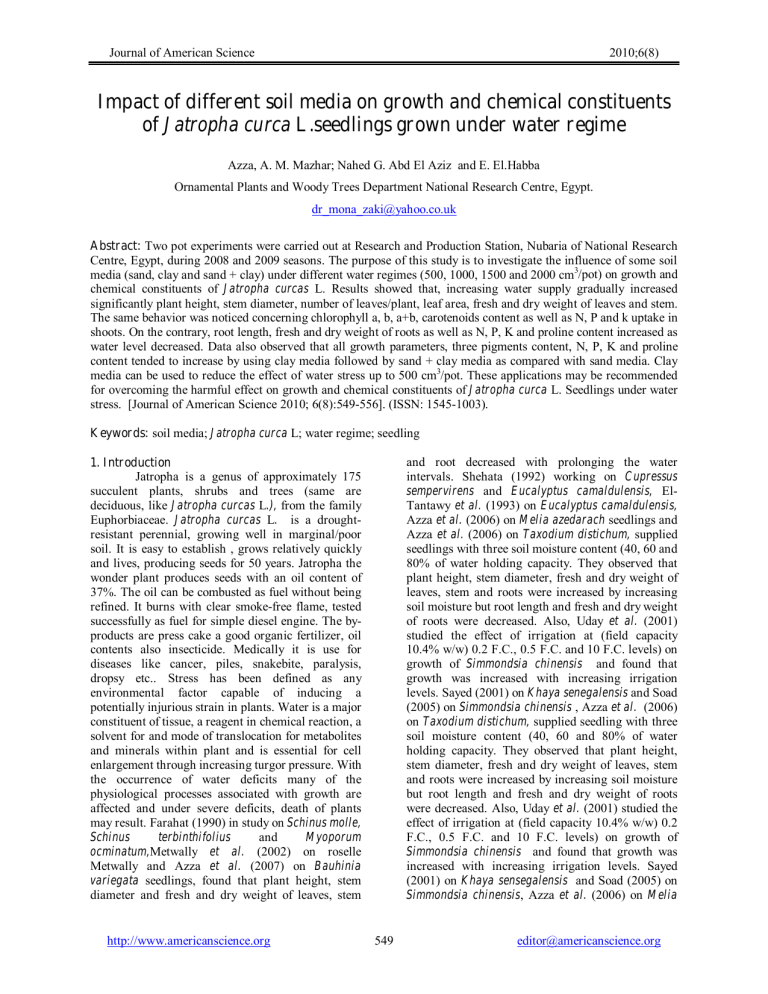
Journal of American Science 2010;6(8) Impact of different soil media on growth and chemical constituents of Jatropha curca L.seedlings grown under water regime Azza, A. M. Mazhar; Nahed G. Abd El Aziz and E. El.Habba Ornamental Plants and Woody Trees Department National Research Centre, Egypt. [email protected] Abstract: Two pot experiments were carried out at Research and Production Station, Nubaria of National Research Centre, Egypt, during 2008 and 2009 seasons. The purpose of this study is to investigate the influence of some soil media (sand, clay and sand + clay) under different water regimes (500, 1000, 1500 and 2000 cm3/pot) on growth and chemical constituents of Jatropha curcas L. Results showed that, increasing water supply gradually increased significantly plant height, stem diameter, number of leaves/plant, leaf area, fresh and dry weight of leaves and stem. The same behavior was noticed concerning chlorophyll a, b, a+b, carotenoids content as well as N, P and k uptake in shoots. On the contrary, root length, fresh and dry weight of roots as well as N, P, K and proline content increased as water level decreased. Data also observed that all growth parameters, three pigments content, N, P, K and proline content tended to increase by using clay media followed by sand + clay media as compared with sand media. Clay media can be used to reduce the effect of water stress up to 500 cm3/pot. These applications may be recommended for overcoming the harmful effect on growth and chemical constituents of Jatropha curca L. Seedlings under water stress. [Journal of American Science 2010; 6(8):549-556]. (ISSN: 1545-1003). Keywords: soil media; Jatropha curca L; water regime; seedling and root decreased with prolonging the water intervals. Shehata (1992) working on Cupressus sempervirens and Eucalyptus camaldulensis, ElTantawy et al. (1993) on Eucalyptus camaldulensis, Azza et al. (2006) on Melia azedarach seedlings and Azza et al. (2006) on Taxodium distichum, supplied seedlings with three soil moisture content (40, 60 and 80% of water holding capacity. They observed that plant height, stem diameter, fresh and dry weight of leaves, stem and roots were increased by increasing soil moisture but root length and fresh and dry weight of roots were decreased. Also, Uday et al. (2001) studied the effect of irrigation at (field capacity 10.4% w/w) 0.2 F.C., 0.5 F.C. and 10 F.C. levels) on growth of Simmondsia chinensis and found that growth was increased with increasing irrigation levels. Sayed (2001) on Khaya senegalensis and Soad (2005) on Simmondsia chinensis , Azza et al. (2006) on Taxodium distichum, supplied seedling with three soil moisture content (40, 60 and 80% of water holding capacity. They observed that plant height, stem diameter, fresh and dry weight of leaves, stem and roots were increased by increasing soil moisture but root length and fresh and dry weight of roots were decreased. Also, Uday et al. (2001) studied the effect of irrigation at (field capacity 10.4% w/w) 0.2 F.C., 0.5 F.C. and 10 F.C. levels) on growth of Simmondsia chinensis and found that growth was increased with increasing irrigation levels. Sayed (2001) on Khaya sensegalensis and Soad (2005) on Simmondsia chinensis, Azza et al. (2006) on Melia 1. Introduction Jatropha is a genus of approximately 175 succulent plants, shrubs and trees (same are deciduous, like Jatropha curcas L.), from the family Euphorbiaceae. Jatropha curcas L. is a droughtresistant perennial, growing well in marginal/poor soil. It is easy to establish , grows relatively quickly and lives, producing seeds for 50 years. Jatropha the wonder plant produces seeds with an oil content of 37%. The oil can be combusted as fuel without being refined. It burns with clear smoke-free flame, tested successfully as fuel for simple diesel engine. The byproducts are press cake a good organic fertilizer, oil contents also insecticide. Medically it is use for diseases like cancer, piles, snakebite, paralysis, dropsy etc.. Stress has been defined as any environmental factor capable of inducing a potentially injurious strain in plants. Water is a major constituent of tissue, a reagent in chemical reaction, a solvent for and mode of translocation for metabolites and minerals within plant and is essential for cell enlargement through increasing turgor pressure. With the occurrence of water deficits many of the physiological processes associated with growth are affected and under severe deficits, death of plants may result. Farahat (1990) in study on Schinus molle, Schinus terbinthifolius and Myoporum ocminatum,Metwally et al. (2002) on roselle Metwally and Azza et al. (2007) on Bauhinia variegata seedlings, found that plant height, stem diameter and fresh and dry weight of leaves, stem http://www.americanscience.org 549 [email protected] Journal of American Science 2010;6(8) azedarach and Azza et al. (2007) on Bouhinia variegata, irrigated seedling with different soil moisture content. They found that chlorophyll ( a, b and carotenoid content) were increased as soil moisture content decreased. In addition to that total sugars, N, P and K concentration in the leaves were also stimulated gradually by decreasing water supply. While, leaf content of nitrogen, phosphorus and potassium were increased by increasing water supply. Azza et al., (2006) on Taxodium distichum found that increasing water supply gradually increased N, P and k uptake in shoot. Data also revealed that proline tended to increase by decreasing water level. spring, sticky when wet and very hard when dry. Clay sails hold moisture and nutrients well and remain warm, in the autumn because they are slow to cool down. Mach of the water they contain will not be available to plants and in winter they are prone to water logging. (James and Michael, 2009). ElSallami (2003) on Leucaena leucocephala seedlings, El-Khalifa (2003) on Dalbergia melanoxylon, Mohmood (2005) on Caesalpinia pulcherrima and Thevetia peruviana and Kathiravan et al. (2008) on Jatropha curcas, found that, clay soil was superior to sandy one in stimulating the morphological growth. Abd-El-Razek (2002) on Gasteria verrucosa and Haworthia fasciata plants and El-Sallami (2003) on Lucaena leucocephala seedlings, found that clay medium gave the highest chlorophyll (a and b), N, P, K percentages and total carbohydrates compared with sandy medium. Mahmood (2005) showed that N, P and K content in leaves exhibited maximum values under the clay + sand medium of Caesalpinia pulcherrima and Thevetia peruviana. Successful greenhouse and nursery production of container-grown plants is largely dependent on the chemical and physical properties of the growing media. An ideal potting medium should be free of weeds and diseases, heavy enough to avoid frequent tipping over and yet light enough to facilitate handling and shipping. The media should also be well drained and yet retain sufficient water to reduce the frequency of watering. Other parameters to consider include cost, availability, consistency between batches and stability in the media overtime. Selection of the proper media components is critical to the successful production of plants. (James and Michael, 2009). The aim of the present work is the evaluate the influence of different soils media (sand,clay and mix. soil) grown under several irrigation levels. 2. Material and Methods This study was carried out at Research and Production Station, Nubaria of National Research Centre during two successive summer seasons of 2008-2009. The main objective of this study was to investigate the effect of different soil types under different water regimes on growth and chemical constituents of Jatropha curcas. The physical properties of the different media are shown in Tables (1a& 1b). Sandy soil: soils with a high proportion of sand drain easily, so water logging is not a problem unless a "pan" or impervious layer has formed below the surface. Their open structure means that they are easy to work and quick to warm up in the spring, allowing earlier sowing and plating. However sandy soils do dry out very quickly and nutrients are easily washed through the soil. Clay soil: These are heavy and difficult to work. They are slow to warm in the (1a)- Mechanical analysis Soil sample Coarse sand% Fine sand % Silt + Clay % Clay 43.0 13.0 44.0 Sand 72.5 16.5 11.0 (1b) Chemical analysis: Soil E.C. Anion (meq/L.) sample m.mohs/cm3 Clay 2.9 7.9 33.0 4 21 5 21 5 3 Sand 2.4 7.1 23.0 2 23 - 4 3 20 pH http://www.americanscience.org Cation (meq/L.) SP% HCO3- 550 Cl- SO4-- Ca++ Mg++ Na++K+ [email protected] Journal of American Science 2010;6(8) One year-old seedlings of Jatropha curcas L. were obtained from nursery of Forestry Department Horticulture Research Institute, Agriculture Research Centre. The seedlings were planted on 15th March in plastic pots 30 cm diameter (one plant/pot, the average height of seedlings were 12-15cm), each pot filed with three different soil media according to treatments i.e. sand, clay and the mixture of them 1: 1 (v/v). The irrigation schedule was four treatments (500, 1000, 1500 and 2000 cm3/ pot). After one month from transplanting, the irrigation regime was started and was terminated in 15th November. The available commercially fertilizer used through this experimental work was kristalan (NRK 19: 19: 19) produced Phayzen campany, Halland. The fertilizer rates were 20.0gm/pot in four equal does after 4,8, 16 and 20 weeks from transplanting. Monayeri et al. (1985) reported that the vital roles of water supply at adequate amounts for different physiological processes such as photosynthesis respiration, transpiration translocation, enzyme reaction and cells turgidity occurs occurs simultaneously. Such reduction could be attributed to a decrease in the activity of meristemic tissues responsible for elongation, as well as the inhibition in photosynthetic efficiency under insufficient condition (Siddique et al., 1999). Ali et al., (1999) indicated that soil drying decreased leaf growth thereby reducing leaf water status in addition to accumulation of organic solutes to osmotic adjustment which in turn inhibit the incorporation of small substrate molecules into the polymers needed to grow new cell. On contarary, all water prementioned vegetative growth parameters root length and fresh and dry weight of roots took on opposite trend as they were gradually decreased with the irrigation levels was sloping upward. The lower water supply causes the root system to penetrate deeper and extending wider in the soil with higher root system researching for moisture in lower. This results were on line with those reported by Burman et al. (1991)on Simmondsia chinensis Uday et al. (2001) and Azza et al., (2006) on Taxodium distichum. The following data were recorded: Plant height (cm), leaves number/ plant, root length (cm), stem diameter (mm), leaf area (cm2), fresh and dry weight of leaves, stems and roots (gm). The experiment was sitting in completely Randomized experiment Design with four irrigation rates and three types of soil to give 12 treatments with 6 replicats. The obtained results was subjected to statistical analysis of variance according to the method described by Snedecor and Cochran (1980) and the combined analysis of the two seasons was calculated according to the method of Steel and Torrie (1980). The following chemical analysis was determined: Chlorophyll a, b and carotenoids contents were determined according to Saric et al., (1967). The proline concentration was determined using fresh material according to Bates et al., (1973). Nitrogen, phosphorus, potassium and sodium contents of leaves were determined according to the method described by Cottenie et al., (1982). The physical and chemical properties of the soil were determined according to Chapman and Pratt (1961). Data in Tables ( 2-5) showed that clay and mix. media significantly increased all growth parameters in the two seasons compared with the sandy soil which gave the lowest values. Clay minimized this reductory effects ,while mix. medium gave a moderate values in this respect. This effect may be attributed to the physical properties of the soil. Sand soil is parous, the ions absorption is more easy while some of ions adhere on the clay soil particles. Also, sandy soils do dry out very quickly and nutrients are easily washed through the soil while, clay soils hold moisture and nutrients well. These results were confirmed by El-Mesiry and Azza (2001) on Melia azedarach L., El-Sallami (2002) on Chorisia speciosa, Leucaena leucocephala and Prosopis Juliflora, El-Khalifa (2003) on Dalbergia melanoxylon plant and Kathiravan et al. (2008) on Jatropha curcas L. 3. Results and Discussion Vegetative growth: The results obtained in Tables (2-5) showed that the above-ground vegetative growth including plant height, leaves number/ plant, stem diameter, leaf area and fresh and dry weight of shoot were gradually increased as the level of water irrigation was sloping upward. The highest values for all these characters were obtained due to the use of the high irrigation level (2000cm3). The results presented in Tables (25) declared that clay and mix. media minimized the reductory effect of water irrigation levels compared with the sandy soil. Therefore,plant grown in clay media and irrigated with 2000 cm3 treatment relatively increased the all morphological growth followed by mix. media compared with the sandy soil under irrigated with 500cm rate which produced the lowest values in the two seasons. The reduction in these growth parameters under low irrigation level (500cm3) conditions may be attributed to losses of tissue water which inhibiting cell division and enlargement. El – http://www.americanscience.org 551 [email protected] Journal of American Science 2010;6(8) the minerals from soil. In agreement with these results concerning irrigation were the results of Sayed (2001) on some woody trees, Soad (2005) on jojoba and Azza et al., (2007) on Bauhinia variegata. Chemical constituents: Pigments content : From the given data in Table ( 6 ) it can be concluded that, increasing irrigation rates caused an increase in the content of photosynthetic pigments (chlorophyll a, b, a+b and carotenoids). Accordingly it can be stated that irrigation with 2000 cm3 was the most effective irrigation treatment for promoting the synthesis and accumulation of the three photosynthetic pigments. In harmony with these results were those obtained by Soad (2005) on jojoba seedlings and Azza et al., (2006) on Taxodium distichum. Furthermore, sodium content increased by increasing irrigation levels in plant, these results run parallel with those obtained by Farahat (1990) on Scinus molle L. Myoprum acumination and ElTantawy et al., (1993) on Eucalyptus camaldulensis. Concerning the effect of soil media, it is evident from data that the previous minerals in plant in the tow growing seasons, were increased by using clay media, following by mix media. But, sodium content took an opposite menner, it decreased by using clay media. This effect was found in the two seasons and it may be attributed to the ability of such soil to supply the plant with its needs from nutrients. These results were confimed by El-Sallami (2003) on Leucaena leucocephala. Concerning ineraction between clay media + irrigation by 500 cm3 showed that maximum values for each element. Clay media tended to increase chlorophyll a, b, a+b and carotenoids as comparing with the sandy and mix.media in fresh leaves. These results are in accordance with those obtained by Sayed (2001) on khya and El-Sallami (2003) on Leucaena leucocephala plant . Seedling grown in clay soil and irrigated with 2000cm3 rate produced the greatest photosynthetic pigments of fresh leaves . The increment effect on chlorophyll a ,b, a+b and carotenoids by 38.3,50.3,42.8 and 40.8% respectively compared with sand soil that was irrigated with 500cm3 rate which produced the lowest value. On the contrary of N, P and K uptake as influenced by irrigation treatments, plant uptake of such four nutrients were gradually increased by increasing irrigation level. These results could be explained in high of the considerable increase in leave dry weight by the increase in irrigation level. In harmony with the prementioned results were finding of Soad (2005) on Jojoba seedlings and Azza et al., (2007) on Bauhinia variegata. Proline content: From the given data in Table ( 7 ) it can be concluded that decreasing irrigation level caused an increase of proline content. This may be due to the proline metobdism which is a typical mechanism of biochemical adaptation subjected to stress condition . The catabolism of proline involves its conversion to glutamic acids via. Pyrroline-scarboxylate reduction and subsequent metabolism of glutamate by Kreb cycls veactin that release CO2 as the end product (Armestrong, 1993). Obtained results were in harmony with the finding of Azza et al. (2006) on Taxodium distichum. Leaves uptake of each of nitrogen, phosphorus and potassium were increased due to the use of the clay soil than mix media and sand media. Similar results were obtained by El-Sallami (2003) on Leucaena leucocephala. In the interaction between clay soil and irrigation by 2000 cm3 showed the maximum uptake of each elements, except Na uptake, it obtaine the lowest uptake. Soil media results on proline content had a similar trend as that in the photosynthetic pigments. Clay and mix.med increased the average proline content of leaves in both seasons compared with sandy soil. Seedlings grown in clay media which was irrigated with 500cm3 gave the highest proline content followed by mix.media + 500cm3 and sand +500 cm3 respectively. The results in this study indicated that clay soil media can be used to overcome the reduction effect of water regimes. Minerals content : It is evident from the data in Tables (7 - 9 ) that minerals content under investigation ( N,P and K )were gradually increase with decreasing the water supply. Regarding irrigation level from 2000cm3 and up to 500cm3 caused an increase in pervious minerals concentrations. This may be due to the leaching of http://www.americanscience.org 552 [email protected] Journal of American Science 2010;6(8) Table (2) Effect of soil types on plant height (cm), number of leaves/plant and root length (cm) of Jatropha curcas.L.plant grown under water regime condition (Average of two seasons 2008 and 2009). Characters Treatments Soil Types Sand Clay Sand+ Clay Mean L.S.D at 5% Soil types (S) Water regime (W) (S)*(W) Plant height (cm) Water regime (cm3/pot) 1000 1500 2000 74.3 79.0 86.3 132.3 147.0 161.7 89.7 94.0 96.3 98.7 106.6 114.7 500 75.0 131.3 86.7 97.6 Mean 78.7 143.1 91.6 Number of leaves/plant Water regime (cm3/pot) 1000 1500 2000 32.0 33.0 35.0 52.0 58.0 63.3 39.6 41.7 46.0 41.0 44.2 48.1 500 27.7 48.7 36.7 37.3 Mean 31.9 55.5 40.8 500 30.0 48.0 37.7 38.5 Root length (cm) Water regime (cm3/pot) 1000 1500 2000 29.6 28.3 25.3 47.6 44.0 39.3 36.6 32.6 31.0 37.9 34.9 31.8 7.3 9.5 4.7 6.7 1.8 2.6 12.11 7.3 3.1 Mean 28.3 44.7 34.5 Table (3) Effect of soil types on leaves, stems and roots fresh weight (gm) of Jatropha curcas L. plant grown under water regime condition (Average of two seasons 2008 and 2009). Characters Treatments Soil Types Sand Clay Sand+ Clay Mean L.S.D at 5% Soil types(S) Water regime(W) (S)*(W) 500 62.42 130.17 80.88 Leaves fresh weight (gm) Water regime (cm3/pot) 1000 1500 2000 72.74 74.95 86.68 177.57 210.40 247.04 89.23 103.67 117.32 91.16 113.18 129.67 Mean 74.20 191.29 97.77 150.34 500 165.62 349.37 237.47 Stem fresh weight (gm) Water regime (cm3/pot) 1000 1500 2000 182.68 195.10 224.13 381.91 410.95 447.95 261.25 285.96 315.05 250.82 275.28 297.33 Mean 191.88 397.54 274.93 329.04 500 69.35 158.99 93.11 Roots fresh weight (gm) Water regime (cm3/pot) 1000 1500 2000 56.09 44.20 43.83 122.49 115.79 99.33 73.12 70.22 69.35 106.48 83.90 76.73 7 13 11.62 7.35 8.92 13.53 9.33 11.31 15.71 11.93 Mean 52.86 124.15 76.45 70.83 Table (4) Effect of soil types on leaves, stems and roots dry weight (gm) of Jatropha curcas L. plant grown under water regime condition (Average of two seasons 2008 and 2009). Characters Treatments Soil Types Sand Clay Sand+ Clay Mean L.S.D at 5% Soil types(S) Water regime(W) (S)*(W) 500 9.05 23.56 13.10 Leaves dry weight (gm) Water regime (cm3/pot) 1000 1500 2000 10.83 11.54 13.78 33.38 40.32 49.16 14.99 17.86 20.64 15.23 19.73 23.24 27.86 Mean 11.30 36.60 16.64 500 62.45 98.17 72.45 Stem dry weight (gm) Water regime (cm3/pot) 1000 1500 2000 69.75 77.78 86.95 109.61 120.00 133.49 79.75 87.78 96.95 77.69 86.37 95.19 105.80 Mean 74.23 115.31 84.23 500 20.74 55.32 30.45 Roots dry weight (gm) Water regime (cm3/pot) 1000 1500 2000 17.00 13.12 12.80 42.01 38.90 32.97 23.69 22.18 21.56 35.50 27.56 24.73 2.60 4.35 2.86 3.01 6.75 4.53 4.63 7.88 6.12 Mean 15.91 42.30 24.47 22.49 Table (5) Effect of soil types on stem diameter (mm) and leaf area (cm2) of Jatropha curcas L. Plant grown under water regime condition (Average of two seasons 2008 and 2009). Characters Treatments Soil Types Sand Clay Sand+ Clay Mean L.S.D.at 5% Soil Typs(S) Water regime(W) (S)*(W) 500 2.60 3.70 3.30 3.20 http://www.americanscience.org Stem diameter (mm) Water regime (cm3/pot) 1000 1500 2000 2.60 3.00 3.20 3.80 4.20 4.50 3.50 3.60 3.70 3.30 3.60 3.80 0.04 0.06 0.10 Mean 2.85 4.05 3.52 500 37.32 53.29 49.32 46.64 Leaf area (cm2) Water regime (cm3/pot) 1000 1500 2000 41.05 41.99 42.48 58.42 60.38 68.60 49.52 51.77 52.08 49.66 51.38 54.48 Mean 40.78 60.18 50.67 1.31 2.07 2.71 553 [email protected] Journal of American Science 2010;6(8) Table (6) Effect of soil types on photosynthetic pigments (mg/g F.W.) of Jatropha curcas L. plant grown under water regime condition (Average of two seasons 2008 and 2009). Characters Chlorophyll (a) Chlorophyll (b) 3 Treatments Chlorophyll (a+b) 3 Water regime (cm /pot) Carotenoids 3 Water regime (cm /pot) Water regime (cm3/pot) Water regime (cm /pot) Soil Types 500 1000 1500 2000 Mean 500 1000 1500 2000 Mean 500 1000 1500 2000 Mean 500 1000 1500 2000 Mean Sand 0.732 0.769 0.791 0.822 0.778 0.431 0.467 0.485 0.528 0.477 1.163 1.236 1.276 1.350 1.256 0.235 0.243 0.255 0.264 0.249 Clay 0.968 0.984 0.986 1.013 0.987 0.604 0.624 0.632 0.648 0.627 1.572 1.608 1.618 1.661 1.614 0.308 0.318 0.323 0.331 0.320 Sand+ Clay 0.841 0.891 0.934 0.959 0.906 0.534 0.549 0.585 0.596 0.566 1.375 1.440 1.519 1.555 1.472 0.270 0.278 0.285 0.297 0.282 Mean 0.847 0.881 0.903 0.931 0.523 0.546 0.567 0.590 1.370 1.428 1.471 1.522 0.271 0.279 0.287 0.297 Table (7) Effect of soil types on prolin content, sodium percentage and uptake/plant leaves of Jatropha curcas L. plant grown under water regime condition (Average of two seasons 2008 and 2009). Proline (µmg -1) Characters Sodium % 3 Treatments Sodium – uptake mg/plant 3 Water regime (cm /pot) Water regime (cm3/pot) Water regime( cm /pot) Soil Types 500 1000 1500 2000 Mean 500 1000 1500 2000 Mean 500 1000 1500 2000 Mean Sand 5.7 4.59 3.73 2.91 4.23 1.92 1.76 1.69 1.49 1.72 17.38 19.06 19.50 20.53 19.12 Clay 8.31 7.12 5.32 4.42 6.29 1.49 1.39 1.33 1.15 1.34 45.23 46.40 53.63 56.53 50.45 Sand+ Clay 7.00 5.73 4.93 3.76 5.36 1.64 1.47 1.31 1.23 1.41 21.48 22.04 23.40 25.39 23.08 Mean 7.00 5.81 4.66 3.70 1.68 1.54 1.44 1.29 28.03 29.17 32.18 34.15 Table (8) Effect of soil types on nitrogen, phosphorus and potassium percentage of Jatropha curcas L. plant grown under water regime condition (Average of two seasons 2008 and 2009). Characters Nitrogen % Phosphorus % 3 Treatments Potassium % 3 Water regime (cm /pot) Water regime (cm3/pot) Water regime (cm /pot) Soil Types 500 1000 1500 2000 Mean 500 1000 1500 2000 Mean 500 1000 1500 2000 Mean Sand 0.94 0.90 0.82 0.76 0.83 0.45 0.44 0.38 0.32 0.40 0.85 0.78 0.59 0.53 0.69 Clay 1.23 1.19 1.12 0.99 1.13 0.79 0.71 0.64 0.60 0.69 1.35 1.26 1.20 1.14 1.24 Sand+ Clay 1.07 0.95 0.84 0.80 0.92 0.54 0.52 0.50 0.48 0.51 1.09 1.06 1.02 0.99 1.04 Mean 1.08 1.01 0.93 0.85 0.59 0.56 0.51 0.47 1.10 1.03 0.94 0.89 Table (9) Effect of soil types on nitrogen, phosphorus and potassium uptake mg / plant leaves of Jatropha curcas L. plant grown under water regime condition (Average of two seasons 2008 and 2009). Characters Nitrogen –uptake mg/plant Phosphorus –uptake mg/plant Potassium –uptake mg/plant Treatments Water regime (cm3/pot) Water regime (cm3/pot) Water regime (cm3/pot) Soil Types 500 1000 1500 2000 Mean 500 1000 1500 2000 Mean 500 1000 1500 2000 Mean Sand 85.1 97.5 94.6 104.7 93.8 281.0 306.9 295.6 278.2 296.9 108.8 102.3 100.3 109.9 109.8 Clay 289.8 397.2 451.6 486.7 413.6 775.5 778.2 768.0 800.9 795.6 445.1 490.1 504.1 630.6 524.5 Sand+ Clay 140.2 142.4 150.0 165.1 153.1 391.2 414.7 476.0 507.8 429.6 235.0 235.1 241.6 301.5 254.5 Mean 164.5 199.3 216.1 236.8 458.4 483.7 485.5 497.3 247.4 254.7 259.1 316.0 http://www.americanscience.org 554 [email protected] Journal of American Science 2010;6(8) References 1. Abd- El-Razek, A.I( 2002).Effect of growing media and chemical fertilization on growth and chemical compostion of gasteria of Haworthia plant. M.Sc.Thesis Fac.Agric.,Cairo Univ.,Egypt. 2. Ali, M.; C.R. Jonsen; V.O. Mogensen; M.N. Andersen and I.E. Henson, 1999. Root signaling and osmotic adjustment during intermittent soil during sustain grain yield of field grown wheat. Field Crops Research, 62 (1): 35-52. 3. Amrmstrong, H., 1993. Biochemistry Oxford Univ. Press. 4. Azza, A.M.Mazher, Sahar, M. Zaghloul and A.A. Yassen, 2006. Impact of Boron fertilizer on growth and chemical constituents of Taxodium distichum grown under water regime. World Journal of Agricultural Sciences 2 (4): 412-420. 5. Azza, A.M. Mazher and Saher, M. Zaghloul, 2006. Increasing water deficiency tolerance of Melia azedarach seedlings through application of iron World J. Agric. Sci., 2: 346-351. 6. Azza, A.M. Mazher, A.A. Yassen and Sahar, M. Zaghloul, 2007. Influence of foliar application of 7. 8. 9. 10. 11. 12. 13. 14. 15. 16. 17. 18. 19. potassium on growth and chemical composition of Bauhinia variegata seedlings under different irrigation intervals. World. J. Agric. Sci., 3(1): 23-31. Bates, L.S.; R.R. Waldren and I.D Teare, 1973. Rapid determination of proline for water stress studies. Plant and Soil, 39: 205-207. Burman, U.; S. Kathje, B.A. Garg and A.N. Lahiri, 1991. Water management of transplant seedling of Azadirachta indica in aird areas. Forest-Ecology and Management, 40: 51-63. Chapman, H.D. and P.F. Pratt, 1961. Methods of Analysis for soils, plant and water. Div. of Agric. Sci. Univ of Calif, pp: 309. Cottenie, A., M. Verloo, L.Kiekens, G. Velghe and R. Camerlynck, 1982. Chemical Analysis of Plant and Soil Laboratory of Anolytical and Agrochemistry, State Univ. Ghent. Belgium, pp: 100-129. El-Khalifa,K.F (2003).Nursery establishment of abanus (Dalbergia melanoxylon Guill. And Perr.) Arab Gulf Journal of Scientific Research. 21(3):153-157. El-Mesiry, T.A and Azza, A.M. Mazher, 2001. Studies on the influence of soil media on growth and chemical composition of Melia azedarach L. grown under salt stress conditions. J. Agric. Sci. Mansoura Univ., 26 (3): 1365-1379. El-Monayeri, M.O.; M.Hagazi; H. Ezzat; H.M. Salem and S.M. Tohoun, 1985. Growth and yield of some wheat and barley varieties grown under http://www.americanscience.org 20. 21. 22. 23. 24. 25. 26. 555 different moisture stress levels Annals. Agric., Moshtohor, 20: 231-240. El-Sallami, I. H. (2002). Seedlings esponses of some ornamental trees to soil type and NPK fertilization. Assiut Journal of Agricultural Science, 33(3):49-83. El-Sallami, I. H.(2003). Growth response of Lucaena leucophala Lam. Seedlings to soil type organic manure and yeast. Assiut Journal of agriculture Science, 34(1): 67-98. El-Tantawy, A.S.; Hanafy and M.S. Shehata, 1993. Effect of salinity and soil moisture composition of Eucalyptus camaldulensis, Dehn. Seedings. Minia First. Conf. Hort. Crop, Egypt. Farahat, M.M. 1990. Salinity and tolerance of Scinus molle L., Shinus terbinthifolius Ra. and Myoprum acuminatum R.BR. Ph.D. Thesis, Fac. of Agric. Cairo, Univ. James, A. Robbins and R. Evans, Michael, 2009. Growing media for container production in green house or nursery. Agriculture and Natural Resources. http://www.uaex.edu. Kathiravan, M. ; Ponnuswamy, A.S. and Vanitha, C. (2008). Influence of soil types on elite seedings production in Jatropha (Jatropha curcas L.) Plant Archives, 8(1) 111-113 Metwally, M.Mazrou; M.M.Afify; Hend, E.Wahba; Makarem, A.Mohamed, M.A. Eraki and S. Mahfous, 2002. Effect of irrigation and vapor Gard on growth, yield and chemical composition of roselle. Plant Bull National Research Centre, Egypt, 27: 533-548. Mohamood, S. M. (2005). Effect of different soil media on seed germination. Seedlings growth and NPK content in Caesalpinia pulcherrima and Thevetia peruviana. University of Aden Journal of Natural and Applied Sciences. 9(2):319-330. Shehata, M.S. 1992. Effect of salinity and soil moisture content seedling of Cuperssus sempervirens and Eucalyptus camaldulensis. Ph.D. Thesis, Fac. of Agric. Cairo Univ. Egypt Saric, M.R. Kostrori; T. Cupina and I.Geric, 1967. Chlorophyll determination univ. U. Noven Sadu Prakitikum is kiziologize Bilijaka Beogard, Haucana, Anjiga. Sayed, M., 2001. Effect of some agriculture treatments on growth and chemical composition of some woody trees seedlings. Ph.D. Thesis, Fac. of Agric. Minia Univ. Egypt. Siddique, M.; R.B. Hamid and M.A. Islam, 1999. Drought stress effect on photosynthetic rate and leaf gas exchange of wheat. Botanical Bull. of Academia Sinica, 40: 141-145. Snedecor, G. Wand W.G. Cochran, 1980. Statistical Methods. 7th ed. Iowa Stat Univ. Press Amer, Iowa, USA. [email protected] Journal of American Science 2010;6(8) 27. Soad, M.M. Ibrahim, 2005. Responses of vegetative growth and chemical composition of jojoba seedlings to some agricultural treatments. Ph.D. Thesis, Fac. of Agric. Minia Univ. Egypt. 28. Steel, R.G.D. and J.H. Torrie, 1980. Principales and Procedures of Statistics. McGrow- hill book Co., Inc., Newyork, Toronto, London. 29. Uday, B; M.D. Bohra, L.N. Harsh; J.C. Tiwari and U. Burman, 2001. Water relation and growth of Simmondsia chinensis and Prasopis Juliflord seedlings at nursery stage. Indian Forester, 127: 351-357. 8/2/2010 http://www.americanscience.org 556 [email protected]
